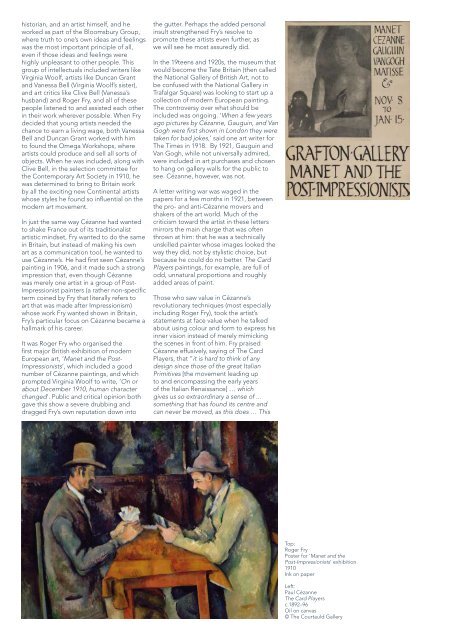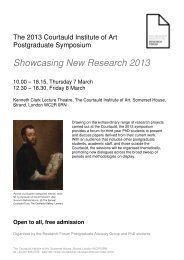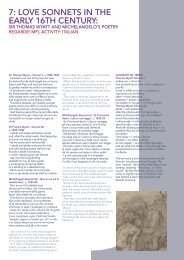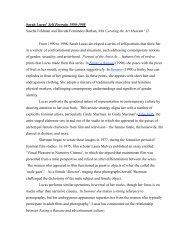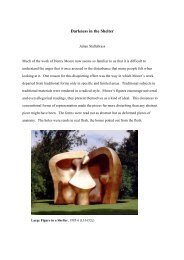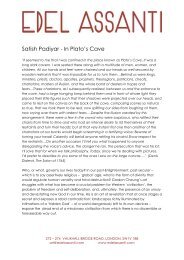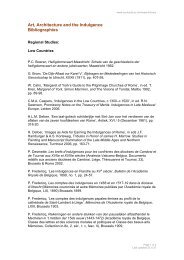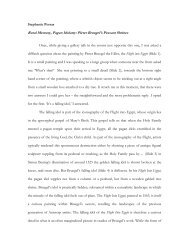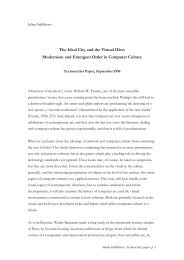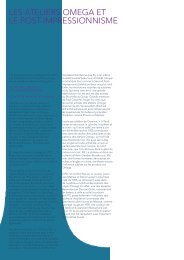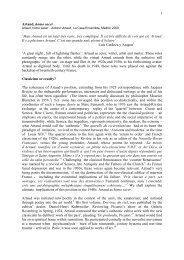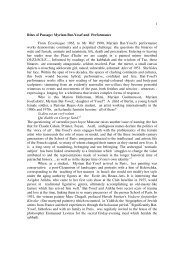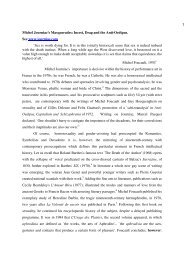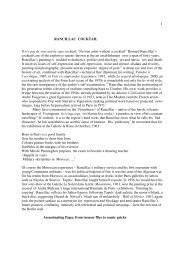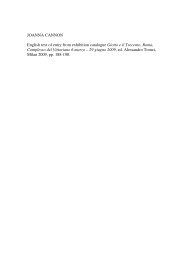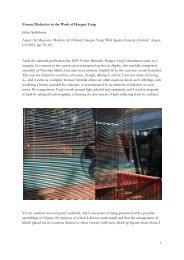TEACHERS' RESOURCE - The Courtauld Institute of Art
TEACHERS' RESOURCE - The Courtauld Institute of Art
TEACHERS' RESOURCE - The Courtauld Institute of Art
Create successful ePaper yourself
Turn your PDF publications into a flip-book with our unique Google optimized e-Paper software.
historian, and an artist himself, and he<br />
worked as part <strong>of</strong> the Bloomsbury Group,<br />
where truth to one’s own ideas and feelings<br />
was the most important principle <strong>of</strong> all,<br />
even if those ideas and feelings were<br />
highly unpleasant to other people. This<br />
group <strong>of</strong> intellectuals included writers like<br />
Virginia Woolf, artists like Duncan Grant<br />
and Vanessa Bell (Virginia Woolf’s sister),<br />
and art critics like Clive Bell (Vanessa’s<br />
husband) and Roger Fry, and all <strong>of</strong> these<br />
people listened to and assisted each other<br />
in their work wherever possible. When Fry<br />
decided that young artists needed the<br />
chance to earn a living wage, both Vanessa<br />
Bell and Duncan Grant worked with him<br />
to found the Omega Workshops, where<br />
artists could produce and sell all sorts <strong>of</strong><br />
objects. When he was included, along with<br />
Clive Bell, in the selection committee for<br />
the Contemporary <strong>Art</strong> Society in 1910, he<br />
was determined to bring to Britain work<br />
by all the exciting new Continental artists<br />
whose styles he found so influential on the<br />
modern art movement.<br />
In just the same way Cézanne had wanted<br />
to shake France out <strong>of</strong> its traditionalist<br />
artistic mindset, Fry wanted to do the same<br />
in Britain, but instead <strong>of</strong> making his own<br />
art as a communication tool, he wanted to<br />
use Cézanne’s. He had first seen Cézanne’s<br />
painting in 1906, and it made such a strong<br />
impression that, even though Cézanne<br />
was merely one artist in a group <strong>of</strong> Post-<br />
Impressionist painters (a rather non-specific<br />
term coined by Fry that literally refers to<br />
art that was made after Impressionism)<br />
whose work Fry wanted shown in Britain,<br />
Fry’s particular focus on Cézanne became a<br />
hallmark <strong>of</strong> his career.<br />
It was Roger Fry who organised the<br />
first major British exhibition <strong>of</strong> modern<br />
European art, ‘Manet and the Post-<br />
Impressionists’, which included a good<br />
number <strong>of</strong> Cézanne paintings, and which<br />
prompted Virginia Woolf to write, ‘On or<br />
about December 1910, human character<br />
changed’. Public and critical opinion both<br />
gave this show a severe drubbing and<br />
dragged Fry’s own reputation down into<br />
the gutter. Perhaps the added personal<br />
insult strengthened Fry’s resolve to<br />
promote these artists even further, as<br />
we will see he most assuredly did.<br />
In the 19teens and 1920s, the museum that<br />
would become the Tate Britain (then called<br />
the National Gallery <strong>of</strong> British <strong>Art</strong>, not to<br />
be confused with the National Gallery in<br />
Trafalgar Square) was looking to start up a<br />
collection <strong>of</strong> modern European painting.<br />
<strong>The</strong> controversy over what should be<br />
included was ongoing. ‘When a few years<br />
ago pictures by Cézanne, Gauguin, and Van<br />
Gogh were first shown in London they were<br />
taken for bad jokes,’ said one art writer for<br />
<strong>The</strong> Times in 1918. By 1921, Gauguin and<br />
Van Gogh, while not universally admired,<br />
were included in art purchases and chosen<br />
to hang on gallery walls for the public to<br />
see. Cézanne, however, was not.<br />
A letter writing war was waged in the<br />
papers for a few months in 1921, between<br />
the pro- and anti-Cézanne movers and<br />
shakers <strong>of</strong> the art world. Much <strong>of</strong> the<br />
criticism toward the artist in these letters<br />
mirrors the main charge that was <strong>of</strong>ten<br />
thrown at him: that he was a technically<br />
unskilled painter whose images looked the<br />
way they did, not by stylistic choice, but<br />
because he could do no better. <strong>The</strong> Card<br />
Players paintings, for example, are full <strong>of</strong><br />
odd, unnatural proportions and roughly<br />
added areas <strong>of</strong> paint.<br />
Those who saw value in Cézanne’s<br />
revolutionary techniques (most especially<br />
including Roger Fry), took the artist’s<br />
statements at face value when he talked<br />
about using colour and form to express his<br />
inner vision instead <strong>of</strong> merely mimicking<br />
the scenes in front <strong>of</strong> him. Fry praised<br />
Cézanne effusively, saying <strong>of</strong> <strong>The</strong> Card<br />
Players, that “it is hard to think <strong>of</strong> any<br />
design since those <strong>of</strong> the great Italian<br />
Primitives [the movement leading up<br />
to and encompassing the early years<br />
<strong>of</strong> the Italian Renaissance] … which<br />
gives us so extraordinary a sense <strong>of</strong> ...<br />
something that has found its centre and<br />
can never be moved, as this does … This<br />
Top:<br />
Roger Fry<br />
Poster for ‘Manet and the<br />
Post-Impressionists’ exhibition.<br />
1910<br />
Ink on paper<br />
Left:<br />
Paul Cézanne<br />
<strong>The</strong> Card Players<br />
c.1892–96<br />
Oil on canvas<br />
© <strong>The</strong> <strong>Courtauld</strong> Gallery


